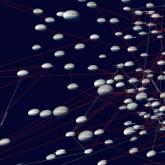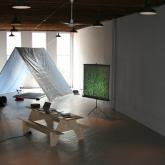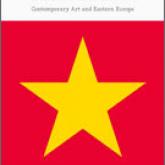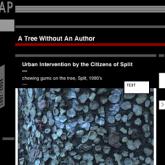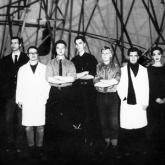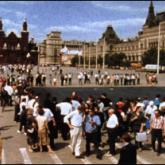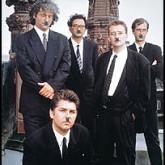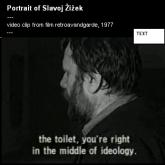East Art Map
IRWIN presentation:
Date: 03-June-2006 (Saturday); 6.00 to 9.00 PM
Location: Basekamp space
Description: Presentation of East Art Map, by Miran Mohar of IRWIN - a group of five artists who make up the visual-arts component of the art collective NSK, based in Ljubljana, Slovenia.
EAM project desription
EAST ART MAP - (RE) CONSTRUCTION OF THE HISTORY OF ART IN EASTERN EUROPE
Every single move of the artist in Western civilization is documented.
But, did you know there is no similar thing in Eastern Europe?!
In Eastern Europe (former communist countries, East & Central Europe or New Europe) there is, as a rule, no transparent structures of events, artifacts and artists significant for the history of art that would be organized into a referential system and accepted and respected outside the borders of a particular country. Instead of them we encounter systems that are closed within national borders, most often based on argumentation adapted to local needs, and sometimes even doubled so that besides official art histories there are a whole series of stories and legends about art and artists who opposed the former. But written records about these latter are few and fragmented. Comparisons with contemporary Western art and artists are extremely rare.
1. A system that is fragmented to such an extent, first of all, prevents any serious possibility to comprehend the art created during the times of socialism as a whole.
2. Secondly, it represents a huge problem of orientation for artists, who, apart from lacking any solid support in their activity, are compelled, for the same reason, to steer between the local and international systems of art.
3. And thirdly, this blocks communication among artists, critics and theoreticians from these countries.
History is not given.
It has to be constructed.
EAM online
East Art Map Online is a tool that will lead you through the last 50 years of the history of visual arts in Eastern Europe.
You will get to know 250 artists/events/projects that are considered of major importance by the 24 invited art critics, curators and artists from the different ex-socialist Central, Eastern and South-Eastern countries invited to make an initial selection for the EAM.
East Art Map Online is now open for contributions by its users.
You are invited to participate in the selection of the ten most important artworks or crucial art projects from every country of Eastern Europe since 1945.
How to participate?
We invite anyone who wishes to, and who thinks s/he has a better idea than the initial selectors, to propose a replacement for any project or artwork included in the EAM.
Send your proposal - complete with a) a written page of text presenting your suggested replacement and the reasons why it should be included, and b) written references confirming the reliability of the date of the work you are proposing for inclusion - to editor@eastartmap.org or submit it directly at this website on the information page of the artist you wish to replace.
All the proposals - provided they contain the requested materials - will be displayed on the website and kept for public discussion until the final decision of the international committee. A feedback area will be installed.
Every two to three months an international committee of six experts will decide whether or not to include any of the proposals submitted.
Any questions should be directed to the editor Inke Arns at editor@eastartmap.org
EAM book
East Art Map: Contemporary Art and Eastern Europe
edited by IRWIN
Reconstructing the missing history of contemporary art, art networks, and art conditions in Eastern Europe from the East European perspective.
The artistic map of Europe contains different degrees of detail and resolution. Italy, France, and Spain are presented in fine grain, but the Balkan peninsula is little more than a vague outline. England, Germany, and Scandinavia have many features filled in, but to the east of Germany things are blurred. Until recently, cities like Sofia, Odessa, Skopje, and Belgrade had next to no definition. Further to the East, Moscow comes into focus, but this is no compensation for the Baltics, sentenced for the last halfcentury to blank space.
In the West, virtually every move of the artist, the art market, and the art public is documented. But in Eastern Europe, no such system of documentation or communication exists. Instead, we encounter systems that are not only inaccessible to the West, but incongruous from one country to the next. Beside the official art histories there is often a whole series of stories and legends about “unofficial,” unapproved art and artists. East Art Map: Contemporary Art and Eastern Europe is an ambitious attempt to reconstruct the missing histories of contemporary art in Eastern Europe from an East European and artistic perspective. It is perhaps the widest ranging art documentation project ever undertaken by the East on the East, involving a large network of artists, scholars, curators and critics coordinated by the IRWIN group over several years.
The editors invited eminent art critics, curators, and artists to present up to ten crucial art projects produced in their respective countries over the past 50 years.The choice of the particular artworks (many of them reproduced in colour), artists, and events, as well as their presentation, was left exclusively to the individual selectors. In addition, the editors asked experts from both East and West to provide longer texts offering cross-cultural perspectives on the art of both regions.
An Afterall book /distribution MIT Press
536 pages
more than 250 color and b&w reproductions
24 selectors
17 essays
selectors and writers:
Inke Arns, Vladimir Beskid, Iara Bubnova, Calin Dan, Ekaterina Degot, Branko Dimitrijevic, Lilia Dragneva, Marina Gržinic, Sirje Helme, Marina
Koldobskaya, Suzana Milevska, Viktor Misiano, Edi Muka, Ana Peraica,
Piotr Piotrowski, Branka Stipancic, János Sugár, Jiri Ševcik, Miško
Šuvakovic, Igor Zabel, Nermina Zildžo
Lutz Becker, Susan Buck-Mors, Roger Conover, Eda Cufer, Michael Fehr, Boris Groys, Jürgen Harten, Sergej Kapus, Erden Kosova, Rastko Mocnik, Andreas Spiegl, Slavoj Žižek
About IRWIN / NSK
Since 1983, the IRWIN artist group has been working with various media, from painting to public art, from sculptural works and installations to publishing. Following their “retro principle”, the five-member-group utilizes and combines different motifs, symbols and signs from the fields of politics and art, which results in the transformation of their historical meaning and content, and in the re-contextualisation and deconstruction of their related ideologies.
Very often, basic information on what NSK is, when it was founded, what the NSK and Laibach philosophies are, and the like are required. To put it in a nutshell, NSK is in its structure a simple and yet complex mechanism which makes any precise explanation in a few words practically impossible. NSK began operating in 1984 as a large collective, a union of various groups brought together by their shared way of thinking and a similar way of expression through different media. The main NSK groups are: Laibach, Irwin, Noordung, New Collectivism Studio and the Department of Pure and Applied Philosophy, while there is a number of flexible subdivisions which emerge as the need arises and disolve under their own inertia. Each of the groups primarily works within its medium, nevertheless their bonds are firm and fruitful. Members of the groups meet on a regular basis, they talk, discuss and plan major common campaigns, test aesthetic and other preferences, exchange ideas and contexts, travel together, etc.
Video screenings
Weekly video compilation
Dates: 03-June-2006 through 31-July-2006; Open during summer hours
(Tuesdays, Thursdays, & Saturdays; 12.00 - 4.00 PM)
Location: Basekamp space
Description: Video compilation of selected artworks included in the “East Art Map” project, by IRWIN (a group of five artists who make up the visual-arts component of the Slovenian art collective NSK).
Weekly video screening list:
1. GROUP OHO
- MOUNT TRIGLAV, 1970
8 mm film of performance
OHO used a number of media (and their in-between forms), such as drawings, photographs, film, video (the first video works in Slovenia were produced in this context in the late 1960`s), music, texts, but also the way of dressing, living and behavior. In the second phase, the group established a dialogue with the contemporary artistic avant-garde: they used (and adapted) the principles of Arte Povera, Process Art, Land Art, Body Art and Conceptual Art. The third phase of OHO’s work represented a combination of Concept Art and a kind of esoteric and ecological approach.
2. NESA PARIPOVIC
- N.P., 1977
8mm film, 22’06” (excerpt 10’32”)
N.P. is an 8mm film showing Nesa Paripovic walking and running through Belgrade’s urban grid of streets and paths, following the unstructured route of an imagined trajectory. He takes an idiosyncratic walk that knows no barriers, crossing fences, climbing roofs, and jumping over balconies. As in his other works, which always deal with the issue of self-representation, the internal rhythms of the body are confronted with social and environmental structures. With this film Paripovic accomplished a significant return to the very origins of a tendency to locate conceptualist artistic acts within everyday behavior - a return to Situationist models of derivee.
3. ION GRIGORESCU
- BOX, 1978
8mm film, 2’45” (excerpt, 1minute)
Grigorescu’s intellectual radicalism, expressed in lonely performances delivered for the camera, is quite unique due to the extreme cultural sophistication lying beneath his very crude images of (fake) self-mutilation and autistic sex. Although feeding from the same sources, his paintings and photographs put more emphasis on surprising cultural associations, radiating the atmosphere of old documentation for an anthropological study of some alien cultures. Combining a poverty of materials, technological improvisation, subliminal cynicism, religious humility and mythological free-associative thinking, Grigorescu has for more than three decades built a paradigmatic image of the human condition under political oppression. His discourse appeals to a wide audience due to a vocabulary developed on the border between pop and arte povera, with a touch of mysticism.
4. RASA TODOSIJEVIC
- WAS IST KUNST, MARINELA KOZELJ, 1978
video, 11’53“ (excerpt 4’45”)
The performance Was Ist Kunst, Marinela Kozelj? exposed a frontally seated female figure who became an object of “investigation” and abuse by the artist, who repeatedly shouted: Was ist Kunst?. A close-up of Kozelj’s face in the video document enhances the effects of intimidation and arrogance, and the very duration of this video makes the performance arduous for the viewer also, due to the traumatic “real-time” transmission of the event. Was Ist Kunst, Marinela Kozelj? is the key piece of Todosijevic’s Was ist Kunst? performances in which he was the first to break with a certain sense of pathos encapsulating the New Art Practice in Yugoslavia. Ideological disillusionment was the fuel for the edgy and challenging works that brought him into the 1980’s, a disillusionment reaching its peak in the early 1990’s with Gott liebt die Serben series. The Was ist Kunst? series could be understood as an ideological pre-figuration of this series, but had more influence on the art projects of NSK in Slovenia then it had on the Belgrade art scene in the 80’s.
5. IRWIN
- BLACK SQUARE ON RED SQUARE, 1992
documentary material, 3’21”
(in collaboration with Kinetikon Pictures)
The NSK Moscow Embassy marked the beginning of Irwin’s journey in the direction of the epistemological heritage of Eastern Europe meeting Western Europe. In this intermediate period, when the East is still the East, and only begins to acquire its problematic Western form, the question of the inner spiritual art and cultural structure, which has lived in it unrecognized for over a century, is of major importance. This was a process of mirroring and reflecting itself and its own Eastern position, in which the recycling of different histories is not directed towards the West, but to a reflection of its own, internal position and its own possibilities for creation.
6. BÁLINT SZOMBATHY
- FLAGS II, 1993
video of performance, 3’58”
Szombathy carried out many projects that could be classified both as land art and analytical art with the aim of erasing the line between art and life by fully understanding the concept of dematerialization and the centrality of the artistic process. In his Lenin in Budapest project, he carried a placard with the image of Lenin through the streets of Budapest in 1972. This same image, which was carried during organized rallies celebrating the Socialist utopia in every corner of the Soviet bloc, appears as a ‚”legitimate” but exaggerating statement of enthusiastic identification with an ideology that can’t be dealt with by the ideology itself.
7. EGLE RAKAUSKAITE
- A TRAP. EXPULSION FROM PARADISE, 1997
video of performance, 4’49”
Rakauskaite’s live sculpture Trap: Expulsion From Paradise (1995) involving a dozen young girls dressed up in confirmands’ dresses, their long hair braided into a tight net, opened the deepest subtle poetry of “virginity,” its subjects shining with modesty and nobility, sometimes glistening with beauty and arrogance or pulsating with philosophical nuances. In her latest projects (mostly videos) the artist combines her previously established strategies with a deeper insight into the contemporary social environment.
8. ANRI SALA
INTERVISTA – FINDING THE WORDS, 1997
Sala belongs to a generation of young artists whose education took place after the political changes in Albania. From this ideological schizophrenia he has learned to push the language of documentary to its radical conclusions, working on the borders between reality and absurdity. Intervista - Finding the Words (1997), his first film, marked one of the most important moments for Albanian contemporary art. The work makes a new approach to short film, an exercise in interpretation and an effort to bridge the distance between the past and present, neutralizing the sense of objectivity traditionally associated with documentaries.
9. THE LJUBLJANA LACAN SCHOOL -
SLAVOJ ZIZEK
INTERVIEW WITH SLAVOJ ZIZEK, 1997
from film Retroavantgarde by M. Gr?inic & A. Šmid, (excerpt 2’41”)
The subcultural movement that arose in Ljubljana within the Student Cultural Center (known as ≈†KUC). in the 1980’s was a manifestation of an exceptional underground collision of art, culture and politics. The most significant strategy of the movement was not to find alternatives to the Communist system, but within it. In this way, the Ljubljana alternative movement clearly shows a deeper change in the actions of the underground movements of Europe, and more specifically, in Eastern Europe. Its theoretical framework was re-articulated by the Lacanian psychoanalytical discourse, most notably through the work of theoretician Slavoj Zizek
10. RASSIM
- CORRECTIONS,1996 – 1998
video documentation, extract 6’22”
The project Corrections involves the redesigning of Rassim’s body into that of a body-builder over a period of one and a half year between 1997 and 1998. Rassim’s unique contribution is based on the creation of an artistic persona and image that is both the artist and the work itself. The strategy of self-promotion of this work/persona in the public space takes the form of gestures that imitate the advertised modes of behavior in the mass media, or the representation of subculture. Taking personal risks, the artist is scanning society in a non-aggressive and non-engaging form while his critique of the new societal order after 1989 involves simulation of the clich√©s of consumerism that have fast become the new ideological dogma.
11. TANJA OSTOJIC
- PERSONAL SPACE, 1998
video of performance, 60’ (excerpt 5’24)
Ostojic’s Personal Space is a very rare example (in contemporary Serbian art) of a work which has avoided the cynicism of the artists of her generation caught between their inability to alter the political events and their disavowal of any kind of torment inflicted upon them by these circumstances. In this performance Ostojic has critically evoked spiritual visions of the body from the medieval spiritual tradition and combined two aspects: nuditas naturalis and nuditas virtualis. This performance exposes the body simultaneously as a human condition of nakedness, either being a sign of vice or a sign of humility, and as a symbol of innocence and the raiment of the soul. Reduction to a virtual body of a woman/child/alien is a disturbing and poignant sign of the desire to be reborn, as pure, empty of thoughts and free to depart from material conditions.
12. JAAN TOOMIK
FATHER AND SON, 1998
Toomik developed his own, post-minimalist artistic code in the 1990’s and since 1994 has mostly been using video as his main medium. Although not tied to any specific mythological or religious dogma, his work carries a strong mystical element. His video installations Way To Sao Paulo (1994), Dancing Home (1995), and Father And Son (1998) are driven by Toomik’s despairing desire to give expression, through his bodily activities, to primeval conditions by repetitively using timeless symbols like water, fire, mirrors, and the sun.
13. COSMOCINETIK CABINET NOORDUNG
/ DRAGAN ZIVADINOV
- BIOMECHANICS NOORDUNG, 1999
project organized and coordinated by PROJECT ATOL FLIGHT OPERATIONS
extract 11’03”
On December 15, 1999, Dragan Zivadinov’s Cosmokinetic Cabinet Noordung Theatre performed Biomechanics Noordung in a Russian IL-76MDK cosmonaut training aircraft, which was operated by the Yuri Gagarin Cosmonaut Training Center, based in Star City just outside Moscow, at an altitude of 6,660 meters. Biomechanics Noordung was staged in zero gravity, researching the revolutionary changes which take place in the human body in a situation of weightlessness. It analyzed contemporary theater and performance phenomena through - in relation to or in spite of - the plethora of new technological and electronic means which are now available.
14. MARINA GRZINIC & AINA SMID
- ON THE FLIES OF THE MARKET PLACE, 1999
video, 6’55”
Grzinic and Smid have been involved with video art since 1982, producing more than 30 video art projects, video and media installations, Internet sites, an interactive CD-Rom and a short film. In using documents and excerpts from books and magazines their video work On The Flies Of The Market Place (1999) raises the question of re-reading the European space. Using references to history, philosophy and the arts, the work elaborates on the idea of Eastern Europe as an indivisible reminder of all European atrocities.
15. VLADIMIR NIKOLIC
- RHYTHM, 2001
video installation, collection Muzej savremene umetnosti Belgrade. extract 10’36”
Five people are filmed standing on a stage while making the Christian-Orthodox sign of the cross, repetitively, following the techno-music beat. What is in fact striking in Nikolic’s powerful video work Rythm from 2001 is that it brings its viewers back to one of the first ideological formulas, which was written in the 18th Century by Blaise Pascal: “Kneel down, move your lips in prayer, and you will believe”. Ideology is in material practices, it resides in bodies and their rituals, and Nikolic renders these rituals redundant.
—
One-night screening: “Predictions of Fire”
Date: 08-July-2006 (This Saturday); 6.00 to 9.00 PM
Location: Basekamp space
Description: Special screening of “Predictions of Fire” (1996 documentary about the Slovenian art collective NSK). This screening accompanies the “East Art Map” project (see below) also at Basekamp throughout June and July 2006.

